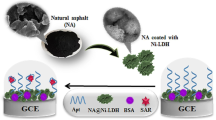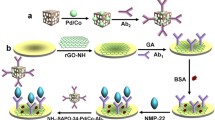Abstract
Sarcosine is one of the known small molecule biomarkers to detect prostate cancer effectively. In the present work, we presented a very simple procedure and low-cost non-enzymatic method for the detection of Sarcosine. Zinc oxide (ZnO) nanoparticles were successfully synthesized, characterized and elucidated the morphology on the Indium tin oxide (ITO) surface, which showed uniform arrangement with a spherical shape. The ITO working electrode modified with ZnO exhibits better analytical characteristics for Sarcosine sensing with a linear range between 5 and 100 nM. The limit of detection was found to be low (7.5 nM) with excellent sensitivity and possess quick response time. Due to its high specificity and repeatability, the ITO/ZnO working electrode does not interfere with the other amino acids in the real samples.










Similar content being viewed by others
References
Villers, A., & Grosclaude, P. (2008). Épidémiologie du cancer de la prostate. Article de revue. Medecine Nucleaire, 32(1), 2–4. https://doi.org/10.1016/j.mednuc.2007.11.003
Stavridis, S., Saidi, S., Lekovski, L. J., Dohcev, S., & Spasovski, G. (2010). Screening for prostate cancer: A controversy or fact. Hippokratia, 14(3), 170–175
Smith, R. A., von Eschenbach, A. C., Wender, R., Levin, B., Byers, T., Rothenberger, D., & Eyre, H., (2001). American Cancer Society Guidelines for the Early Detection of Cancer: Update of Early Detection Guidelines for Prostate, Colorectal, and Endometrial Cancers: ALSO: Update 2001--Testing for Early Lung Cancer Detection. CA: A Cancer Journal for Clinicians, 51(1), 38–75. https://doi.org/10.3322/canjclin.51.1.38
Tang, Z., Huang, J., He, H., Ma, C., & Wang, K. (2020). Contributing to liquid biopsy: Optical and electrochemical methods in cancer biomarker analysis. Coordination Chemistry Reviews, 415, 213317. https://doi.org/10.1016/j.ccr.2020.213317
Sheydaei, O., Khajehsharifi, H., & Rajabi, H. R. (2020). Rapid and selective diagnose of Sarcosine in urine samples as prostate cancer biomarker by mesoporous imprinted polymeric nanobeads modified electrode. Sensors and Actuators, B: Chemical, 309, 127559. https://doi.org/10.1016/j.snb.2019.127559
Ideo, H., Kondo, J., Nomura, T., Nonomura, N., Inoue, M., & Amano, J. (2020). Study of glycosylation of prostate-specific antigen secreted by cancer tissue-originated spheroids reveals new candidates for prostate cancer detection. Scientific Reports, 10(1), 1–13. https://doi.org/10.1038/s41598-020-59622-y
Ryoo, H., Kang, M. Y., Sung, H. H., Jeong, C., Seo, B., Il, S.Jeon, H. G., (2020). Detection of prostate cancer using prostate imaging reporting and data system score and prostate-specific antigen density in biopsy-naive and prior biopsy-negative patients. Prostate International, 8(3), 125–129. https://doi.org/10.1016/j.prnil.2020.03.003
Gao, X., Bao, T., Yang, H., Lei, Y., Jiang, X., Huang, Y., & Tang, H. (2020). The association of metabolic syndrome and its components with serum prostate-specific antigen levels. European journal of cancer prevention: the official journal of the European Cancer Prevention Organisation (ECP), 29(1), 36–41. https://doi.org/10.1097/CEJ.0000000000000508
Lu, Y. C., Huang, C. Y., Lu, Y. C., Huang, K. H., Chow, P. M., Chang, Y. K., & Hong, J. H., (2021). Association between low prostate-specific antigen levels and greater disease progression in high-grade locally-advanced prostate cancer. Journal of the Formosan Medical Association, 120(1), 483–491. https://doi.org/10.1016/j.jfma.2020.06.021
Raciti, P., Sue, J., Ceballos, R., Godrich, R., Kunz, J. D., Kapur, S., & Fuchs, T. J., (2020). Novel artificial intelligence system increases the detection of prostate cancer in whole slide images of core needle biopsies. Modern Pathology, 33(10), 2058–2066. https://doi.org/10.1038/s41379-020-0551-y
McNally, C. J., Ruddock, M. W., Moore, T., & McKenna, D. J. (2020). Biomarkers that differentiate benign prostatic hyperplasia from prostate cancer: A literature review. Cancer Management and Research, 12, 5225–5241. https://doi.org/10.2147/CMAR.S250829
Rodríguez, S. V. M., & García-Perdomo, H. A. (2020). Diagnostic accuracy of prostate cancer antigen 3 (PCA3) prior to first prostate biopsy: A systematic review and meta-analysis. Canadian Urological Association Journal, 14(5), E214–E219
Biswas, A., Rajesh, Y., Mitra, P., & Mandal, M. (2020). ETV6 gene aberrations in non-haematological malignancies: A review highlighting ETV6 associated fusion genes in solid tumors. Biochimica et Biophysica Acta - Reviews on Cancer, 1874(1), 188389. https://doi.org/10.1016/j.bbcan.2020.188389
Prensner, J. R., Rubin, M. A., Wei, J. T., & Chinnaiyan, A. M. (2012). Beyond PSA: The next generation of prostate cancer biomarkers. Science Translational Medicine . https://doi.org/10.1126/scitranslmed.3003180.
Chen, J., Zhang, J., Zhang, W., & Chen, Z. (2014). Sensitive determination of the potential biomarker sarcosine for prostate cancer by LC-MS with N,N’-dicyclohexylcarbodiimide derivatization. Journal of Separation Science, 37(1–2), 14–19. https://doi.org/10.1002/jssc.201301043
Rubin, M. A., Zhou, M., Dhanasekaran, S. M., Varambally, S., Barrette, T. R., Sanda, M. G., & Chinnaiyan, A. M. (2002). α-methylacyl coenzyme A racemase as a tissue biomarker for prostate cancer. Journal of the American Medical Association, 287(13), 1662–1670. https://doi.org/10.1001/jama.287.13.1662
Kosari, F., Asmann, Y. W., Cheville, J. C., & Vasmatzis, G. (2002). Cysteine-rich secretory protein-3: A potential biomarker for prostate cancer. Cancer Epidemiology Biomarkers and Prevention, 11(11), 1419–1426
Cheng, T., Li, F., Wei, R., Lv, M., qin, Zhou, Y., Dai, Y., & Gao, Q., (2017). MMP26: A potential biomarker for prostate cancer. Journal of Huazhong University of Science and Technology—Medical Science, 37(6), 891–894. https://doi.org/10.1007/s11596-017-1823-8
Jentzmik, F., Stephan, C., Miller, K., Schrader, M., Erbersdobler, A., Kristiansen, G., & Jung, K. (2010). Sarcosine in Urine after Digital Rectal Examination Fails as a Marker in Prostate Cancer Detection and Identification of Aggressive Tumours. European Urology, 58(1), 12–18. https://doi.org/10.1016/j.eururo.2010.01.035
Yang, Q., Li, N., Li, Q., Chen, S., Wang, H. L., & Yang, H. (2019). Amperometric sarcosine biosensor based on hollow magnetic Pt–Fe3O4@C nanospheres. Analytica Chimica Acta, 1078, 161–167. https://doi.org/10.1016/j.aca.2019.06.031
Chiou, C. C., Chang, P. Y., Chan, E. C., Wu, T. L., Tsao, K. C., & Wu, J. T. (2003). Urinary 8-hydroxydeoxyguanosine and its analogs as DNA marker of oxidative stress: Development of an ELISA and measurement in both bladder and prostate cancers. Clinica Chimica Acta, 334(1–2), 87–94. https://doi.org/10.1016/S0009-8981(03)00191-8
Baum, C. E., Price, D. K., & Figg, W. D. (2010). Sarcosine as a potential prostate cancer biomarker and therapeutic target. Cancer Biology and Therapy, 9(5), 341–342. https://doi.org/10.4161/cbt.9.5.11310
Liu, T., Fu, B., Chen, J., & Li, K. (2019). An electrochemical sarcosine sensor based on biomimetic recognition. Microchimica Acta, 186(3), 1–8. https://doi.org/10.1007/s00604-019-3240-0
Rebelo, T. S. C. R., Pereira, C. M., Sales, M. G. F., Noronha, J. P., Costa-Rodrigues, J., Silva, F., & Fernandes, M. H. (2014). Sarcosine oxidase composite screen-printed electrode for sarcosine determination in biological samples. Analytica Chimica Acta, 850, 26–32. https://doi.org/10.1016/j.aca.2014.08.005
Wang, J., Su, S., Wei, J., Bahgi, R., Hope-Weeks, L., Qiu, J., & Wang, S. (2015). Ratio-metric sensor to detect riboflavin via fluorescence resonance energy transfer with ultrahigh sensitivity. Physica E: Low-Dimensional Systems and Nanostructures, 72, 17–24. https://doi.org/10.1016/j.physe.2015.04.006
Hrapovic, S., Liu, Y., Male, K. B., & Luong, J. H. T. (2004). Platinum Nanoparticles and Carbon Nanotubes interactions with Pt nanoparticles to form a network that connected Pt nanoparticles to the electrode surface. TEM nanoparticles on carbon nanotubes whereas cyclic volta-. Analytical Chemistry, 76(4), 1083–1088
Chauhan, R., Kumar, A., Umarji, G. G., Mulik, U. P., & Amalnerkar, D. P. (2015). Comparison of optical and photovoltaic properties of ZnO chemically synthesized by using different hydrolyzing agents. Journal of Solid State Electrochemistry, 19(1), 161–168. https://doi.org/10.1007/s10008-014-2568-y
Marrani, A. G., Caprioli, F., Boccia, A., Zanoni, R., & Decker, F. (2014). Electrochemically deposited ZnO films: An XPS study on the evolution of their surface hydroxide and defect composition upon thermal annealing. Journal of Solid State Electrochemistry, 18(2), 505–513. https://doi.org/10.1007/s10008-013-2281-2
Wang, X., Chen, X., Luo, D., Zhang, Y., Liu, Y., Sun, L., & Liu, Z. (2014). Electrodeposition of ZnO on carbon nanofiber buckypaper. Journal of Solid State Electrochemistry, 18(6), 1773–1777. https://doi.org/10.1007/s10008-014-2404-4
Prasad, B. E., Kamath, P. V., & Ranganath, S. (2012). Electrodeposition of ZnO coatings from aqueous Zn(NO3) 2 baths: Effect of Zn concentration, deposition temperature, and time on orientation. Journal of Solid State Electrochemistry, 16(12), 3715–3722. https://doi.org/10.1007/s10008-012-1804-6
Gomez, H., Riveros, G., Ramirez, D., Henriquez, R., Schrebler, R., Marotti, R., & Dalchiele, E. (2012). Growth and characterization of ZnO nanowire arrays electrodeposited into anodic alumina templates in DMSO solution. Journal of Solid State Electrochemistry, 16(1), 197–204. https://doi.org/10.1007/s10008-011-1309-8
Tellabati, N. V., Waghadkar, Y. B., Roy, A., Shinde, M. D., Gosavi, S. W., Amalnerkar, D. P., & Chauhan, R. (2015). Optical and photovoltaic properties of temperature-dependent synthesis of ZnO nanobelts, nanoplates, and nanorods. Journal of Solid State Electrochemistry, 19(8), 2413–2420. https://doi.org/10.1007/s10008-015-2890-z
Makarova, M. V., MacOunová, K., & Krtil, P. (2006). The effect of cationic disorder on the optical and electrochemical behavior of nanocrystalline ZnO preparedfrom peroxide precursors. Journal of Solid State Electrochemistry, 10(5), 320–328. https://doi.org/10.1007/s10008-005-0094-7
Kumar, D. D., Nair, B., Justinvictor, P., & Varkey, V. B. (2016). Structural and optical properties of zinc oxide nanorods prepared by aqueous solution route. Chemist, 89, 1–5.
Thirumoorthi, M., & Prakash, T. J., J. (2016). Structure, optical and electrical properties of indium tin oxide ultra thin films prepared by jet nebulizer spray pyrolysis technique. Journal of Asian Ceramic Societies, 4(1), 124–132. https://doi.org/10.1016/j.jascer.2016.01.001
Parthasarathy, S., Nandhini, V., & Jeyaprakash, B. G. (2016). Improved sensing response of photo activated ZnO thin film for hydrogen peroxide detection. Journal of Colloid and Interface Science, 482, 81–88. https://doi.org/10.1016/j.jcis.2016.07.066
Idris, A. A. M., Arsat, R., Ahmad, M. K., & Sidek, F. (2017). Comparison of deposition methods of ZnO thin film on flexible substrate. Indonesian Journal of Electrical Engineering and Computer Science, 5(3), 536–541. https://doi.org/10.11591/ijeecs.v5.i3.pp536-541
Akhtari, F., Zorriasatein, S., Farahmandjou, M., & Elahi, S. M. (2018). Synthesis and optical properties of Co2+-doped ZnO Network prepared by new precursors. Materials Research Express. https://doi.org/10.1088/2053-1591/aac6f1.
Swapna, R., & Santhosh Kumar, M. C. (2012). The role of substrate temperature on the properties of nanocrystalline Mo doped ZnO thin films by spray pyrolysis. Ceramics International, 38(5), 3875–3883. https://doi.org/10.1016/j.ceramint.2012.01.039
He, J., Tan, B., Su, Y., Yang, S., & Wei, Q. (2012). XPS analysis of ZnO thin films obtained by pulsed laser deposition. Advanced Materials Research, 383–390, 6293–6296. https://doi.org/10.4028/www.scientific.net/AMR.383-390.6293
Swapna, R., Ashok, M., Muralidharan, G., & Kumar, M. C. S. (2013). Microstructural, electrical and optical properties of ZnO:Mo thin films with various thickness by spray pyrolysis. Journal of Analytical and Applied Pyrolysis, 102, 68–75. https://doi.org/10.1016/j.jaap.2013.04.001
Cui, H. F., Ye, J. S., Zhang, W., De, Li, C. M., Luong, J. H. T., & Sheu, F. S. (2007). Selective and sensitive electrochemical detection of glucose in neutral solution using platinum-lead alloy nanoparticle/carbon nanotube nanocomposites. Analytica Chimica Acta, 594(2), 175–183. https://doi.org/10.1016/j.aca.2007.05.047
Arya, S. K., Saha, S., Ramirez-Vick, J. E., Gupta, V., Bhansali, S., & Singh, S. P. (2012). Recent advances in ZnO nanostructures and thin films for biosensor applications: Review. Analytica Chimica Acta, 737, 1–21. https://doi.org/10.1016/j.aca.2012.05.048
Narwal, V., Kumar, P., Joon, P., & Pundir, C. S. (2018). Fabrication of an amperometric sarcosine biosensor based on sarcosine oxidase/chitosan/CuNPs/c-MWCNT/Au electrode for detection of prostate cancer. Enzyme and Microbial Technology, 113, 44–51. https://doi.org/10.1016/j.enzmictec.2018.02.010
Samanta, S., Rahaman, S. Z., Roy, A., Jana, S., Chakrabarti, S., Panja, R., & Ray, S. K. (2017). Understanding of multi-level resistive switching mechanism in GeOx through redox reaction in H2O2/sarcosine prostate cancer biomarker detection. Scientific Reports, 7(1), 1–12. https://doi.org/10.1038/s41598-017-11657-4
Yamkamon, V., Phakdee, B., Yainoy, S., Suksrichawalit, T., Tatanandana, T., Sangkum, P., & Eiamphungporn, W. (2018). Development of sarcosine quantification in urine based on enzyme-coupled colorimetric method for prostate cancer diagnosis. EXCLI Journal, 17, 467–478. https://doi.org/10.17179/excli2018-1245.
Talin Lui, B., Fu, J. C., & Kang Li. (2019). .An electrochemical sarcosine sensor based on biomimetic recognition. MicrochimicaActa, 186, 136. https://doi.org/10.1007/s00604-019-3240-0.
Wang, Q., Yang, C., Yang, Q., Yu&, S., & H Yang. (2019). Platinum-loaded mesoporous nickel phosphonate and its electrochemical application for sarcosine detection. Analytica Chimica acta. https://doi.org/10.1016/j.aca.2018.09.027.Elsevier
Thenmozhi Rajarathinam, M., Kwon, D., Thirumalai, S., Kim, S., Lee, J. H., Yoon, H. J., & Chang, S. C. (2021). Polymer-dispersed reduced graphene oxide nanosheets and Prussian blue modified biosensor for amperometric detection of sarcosine. Analytica Chimica Acta, 1175, 338749. https://doi.org/10.1016/j.aca.2021.338749.
Acknowledgements
The authors wish to acknowledge TRR fund, SASTRA Deemed University, for financial and infrastructural support.
Author information
Authors and Affiliations
Corresponding author
Ethics declarations
Conflict of interest
The authors declare no conflict of Interest.
Additional information
Publisher’s Note
Springer Nature remains neutral with regard to jurisdictional claims in published maps and institutional affiliations.
Rights and permissions
About this article
Cite this article
Selvaraj, S., Varshini, K.S., Sonia, T. et al. Spray Deposited ZnO Nanograins for Enzyme-Free Detection of Sarcosine. Sens Imaging 22, 46 (2021). https://doi.org/10.1007/s11220-021-00369-9
Received:
Revised:
Accepted:
Published:
DOI: https://doi.org/10.1007/s11220-021-00369-9




